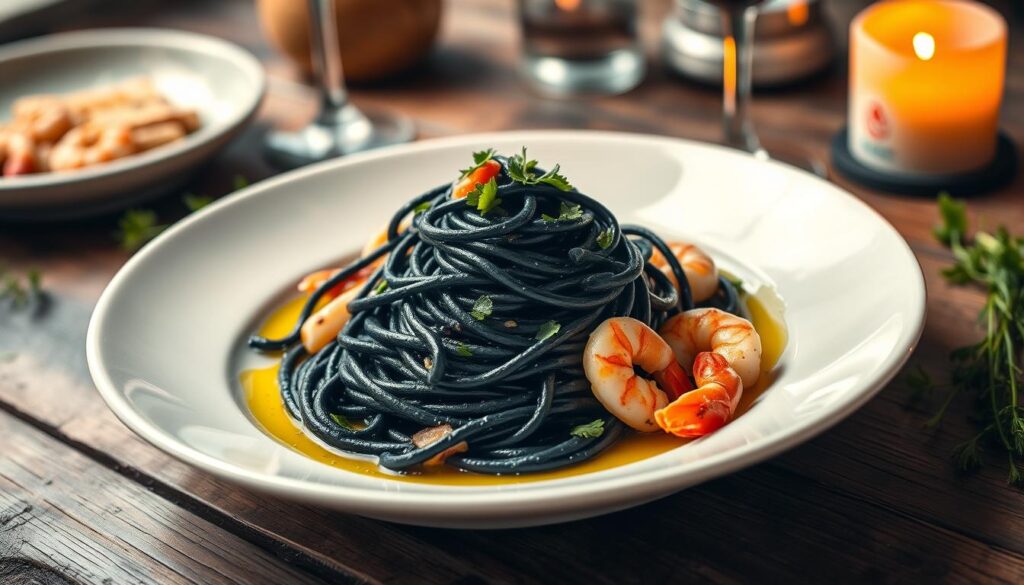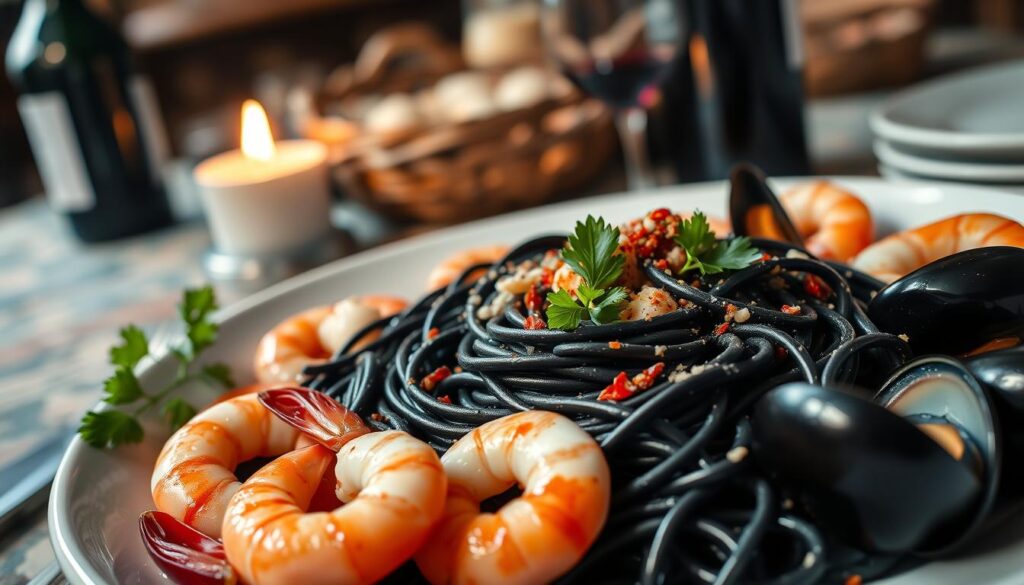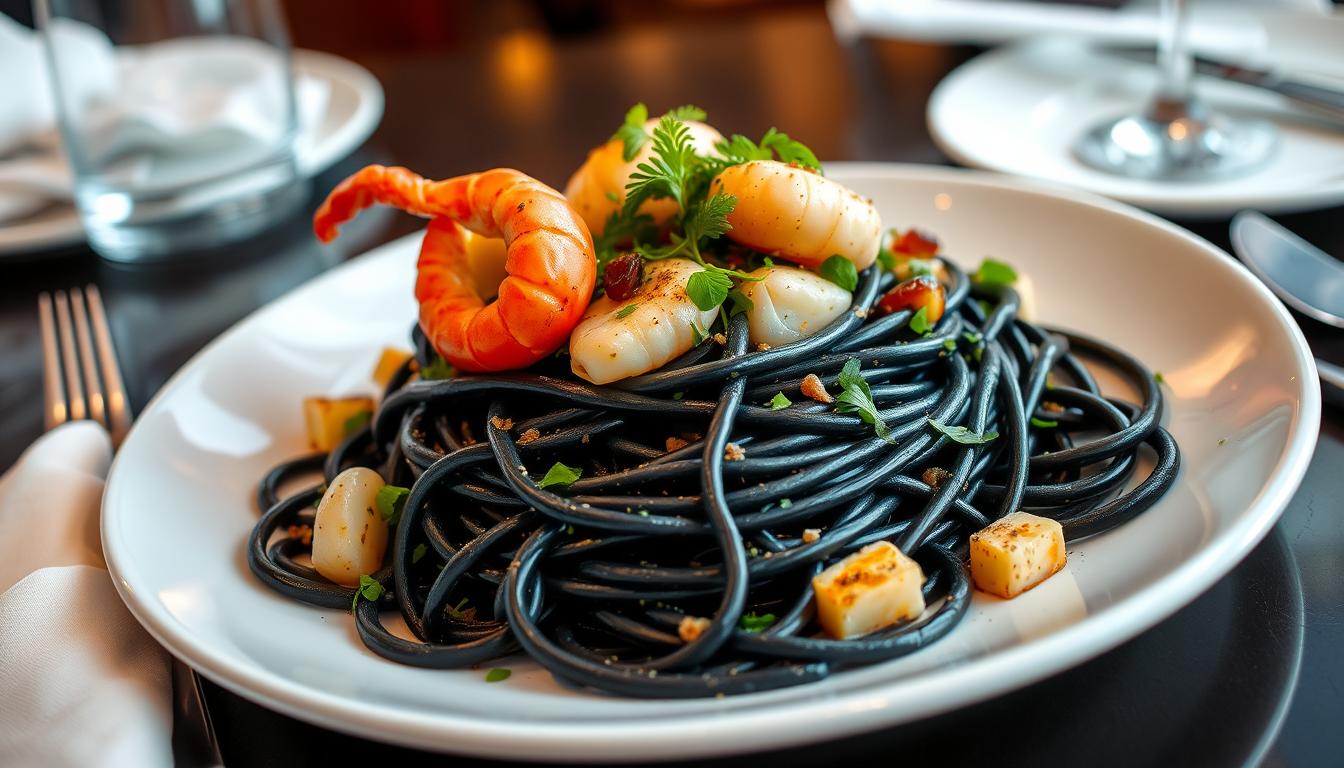I love food and Italian cuisine, and squid ink pasta is a favorite. This black noodle dish, called “Nero di Seppia” in Italy, takes me to the Mediterranean. Its dark color, rich taste, and gourmet status make it special.
Key Takeaways
- Squid ink pasta is a beloved delicacy in Italian cuisine, known for its unique black color and bold, briny flavor.
- This gourmet pasta dish has a long and storied history, with roots tracing back to traditional Mediterranean cooking.
- Squid ink pasta offers a visually striking and flavorful experience, making it a popular choice among food enthusiasts.
- Crafting authentic squid ink pasta at home requires careful attention to ingredients and technique, but the results are well worth the effort.
- Squid ink pasta pairs beautifully with a variety of sauces and wine pairings, making it a versatile and impressive addition to any meal.
Table of Contents
The Ancient Origins of Black Pasta in Italian Cuisine
The history of cuttlefish ink pasta, or nero di seppia, goes back to Italy’s Mediterranean cooking traditions. This black pasta started as a simple fisherman’s dish. Now, it’s a beloved culinary delight.
Traditional Uses of Cuttlefish Ink in Mediterranean Cooking
For ages, coastal towns by the Mediterranean Sea used cuttlefish ink. They prized its rich, dark color for adding bold flavors to food. It was used in risottos, stews, and more.
From Fisherman’s Dish to Culinary Delicacy
- Cuttlefish ink pasta became popular, moving from a simple meal to a favorite among Italian food lovers.
- The black color and salty taste of nero di seppia won over chefs and diners. It evolved into a symbol of fine dining.
- Now, cuttlefish ink pasta is a key part of Italian cuisine. It shows the rich culture and creativity of the Mediterranean.
What Makes Squid Ink Pasta Uniquely Special
I love trying different types of pasta, but squid ink pasta is special. It’s a unique treat that offers a different taste and feel than regular pasta.
The black hue of squid ink pasta catches your eye first. It’s not just for looks; it shows the pasta’s Italian roots. The dark color makes any dish look amazing.
The taste of this gourmet pasta is amazing. It has a rich, umami-forward taste that’s both subtle and strong. This flavor mixes well with the pasta’s sweetness, creating a delicious mix.
The texture of squid ink pasta is also special. It feels velvety, almost creamy in your mouth. The pasta is still firm but feels silky smooth.
In short, black pasta with squid ink is a culinary wonder. It’s a must-try for anyone who loves pasta.
Essential Ingredients for Authentic Nero di Seppia
Making the perfect squid ink pasta, or nero di seppia, needs careful attention to ingredients. You must choose the best squid ink and the right flour and eggs. Each part is crucial for the pasta’s deep black color and its rich, briny taste.
Selecting the Perfect Squid Ink
The squid ink is the heart of nero di seppia. It’s important to find high-quality, pure squid ink. Look for ink that is smooth, glossy, and free of impurities. This ensures the pasta’s texture and taste are top-notch.
Quality Flour and Egg Components
The pasta dough’s foundation is key. Use high-quality flour, like “00” or semolina, for a silky texture. Fresh eggs add richness and help the dough come together, making it pliable.
Additional Ingredients for Enhanced Flavor
While squid ink, flour, and eggs are the main ingredients, adding a few extras can boost flavor. Salt enhances the briny taste. A drizzle of olive oil or a sprinkle of black pepper adds depth and complexity.
| Ingredient | Importance |
|---|---|
| Squid Ink | The star of the show, providing the iconic black color and briny flavor |
| Flour | Determines the pasta’s texture, with “00” or semolina flour being the best choices |
| Eggs | Adds richness and helps bind the dough for a cohesive consistency |
| Salt | Enhances the briny notes of the squid ink |
| Olive Oil | Imparts depth and complexity to the pasta’s flavor profile |
| Black Pepper | Provides a subtle kick of spice to balance the dish |
By carefully choosing and mixing these essential ingredients, you can make the perfect nero di seppia.
The Art of Making Homemade Squid Ink Pasta
Making squid ink pasta at home is a true art. It lets you enjoy the deep flavors and colors of Italian cuisine. As a home cook, I’ve learned a lot and I’m eager to share it with you.
Creating amazing artisanal pasta starts with mixing the squid ink into the dough right. This ingredient gives the pasta a beautiful black color and a hint of saltiness. It goes well with many sauces and dishes.
- Start by getting your ingredients: good flour, eggs, and fresh squid ink.
- Mix the squid ink into the flour gently. This ensures the ink spreads evenly without overpowering the dough.
- Then, knead the dough carefully. Keep kneading until it’s smooth and soft. This step is important for the pasta’s feel and taste.
- After kneading, shape the dough into different pasta forms. You can make spaghetti, ravioli, or tortellini.
The joy of making homemade squid ink pasta is the unique dining experience it offers. By mastering this traditional method, you can bring Italian cuisine into your kitchen. You’ll impress everyone with your cooking skills.
Success comes from focusing on the details and enjoying the creative process. With practice, you’ll make squid ink pasta that rivals any Italian restaurant.
Mastering the Perfect Pasta Dough Consistency
Getting the dough just right is key to making great squid ink pasta at home. Whether you’re making classic tagliatelle or unique pappardelle, the dough’s texture matters a lot. We’ll look at kneading, resting, and rolling to make your homemade squid ink pasta a hit.
Kneading Techniques for Ideal Texture
Kneading is where the magic happens. It builds the gluten that makes squid ink pasta chewy and soft. Start by mixing flour, squid ink, and egg until a dough forms. Then, knead the dough on a floured surface, pushing and folding it with your heel.
This action aligns the gluten strands, making the dough smooth and elastic.
Resting and Rolling Methods
After kneading, let the dough rest. This lets the gluten relax and flavors blend. After 30 minutes to an hour, it’s time to roll it out. Use a pasta machine or a rolling pin to roll the dough thinly and evenly.
This careful rolling is key for the perfect bite and look in your squid ink pasta recipe.
Mastering kneading, resting, and rolling will help you make homemade squid ink pasta as good as any restaurant. Take your time, listen to the dough, and trust your instincts. The result will be a memorable culinary experience.
Common Mistakes to Avoid When Making Black Pasta
Making the perfect black pasta, whether homemade or store-bought, needs careful attention. As a home cook, I’ve seen a few common mistakes. These can ruin your black pasta dishes.
One big mistake is getting the ink-to-flour ratio wrong. Too little ink makes the pasta pale, while too much makes it briny and crumbly. Finding the right balance is key for a deep, glossy black color and a tasty pasta.
Another common problem is overworking the dough. Kneading is important for texture, but too much makes the dough tough. It’s important to know when to stop kneading.
Finally, cooking the black pasta wrong can be a disaster. Overcooking makes it mushy, while undercooking makes it chewy. Getting the cooking time right is crucial for a perfect al dente texture.
By avoiding these mistakes and using the right techniques, you can improve your black pasta skills. With practice and attention to detail, you’ll make homemade squid ink pasta that will impress everyone.
Best Sauce Pairings for Squid Ink Pasta
Pairing sauces with squid ink pasta opens up a world of flavors. You can go for classic seafood sauces or try something new. Let’s explore some top sauce pairings to take your squid pasta to the next level.
Classic Seafood Combinations
Squid ink pasta is perfect with seafood sauces. A seafood pasta sauce with shrimp, clams, and white wine or lemon butter is amazing. The squid ink’s briny taste matches the seafood’s fresh flavors.
Contemporary Sauce Innovations
There are also modern sauce options for squid pasta recipe. A creamy mushroom sauce with white wine and parmesan is sophisticated. Or, a spicy marinara with roasted red peppers adds a bold twist.
Choosing a sauce is all about letting the squid ink pasta’s unique taste stand out. With some experimentation, you’ll find your new favorite seafood pasta pairing.
Wine and Beverage Pairing Suggestions
Pairing drinks with Italian cuisine and gourmet pasta like squid ink pasta can make your meal better. You can choose from classic Italian wines or modern drinks. The right choice can make the flavors of this dish pop.
Classic Italian Wine Pairings
For a real Italian cuisine feel, pair squid ink pasta with a strong red wine. Wines like Chianti or Montepulciano d’Abruzzo match well with the squid ink’s briny taste. Or, a crisp white wine like Vermentino or Greco di Tufo can offer a refreshing contrast.
Innovative Beverage Pairings
- Try a dry gin and tonic for a unique taste. It brings out the sea flavors in the squid ink pasta.
- A light, bubbly Prosecco or Franciacorta adds a fun touch. It balances the dish’s richness.
- If you don’t drink alcohol, a bright Italian soda or Aperol spritz is great. They match the dish’s colors and tastes.
Exploring different drinks can help you find the best match for squid ink pasta. With so many choices, you’ll find the perfect drink to make your gourmet pasta meal unforgettable.
Health Benefits and Nutritional Value
Squid ink pasta, also known as cuttlefish ink pasta, is more than just a pretty sight. It has health benefits and nutritional value that make it great for a healthy diet.
Understanding Squid Ink’s Natural Properties
Squid ink comes from the ink sacs of squid and cuttlefish. It’s full of melanin, a strong antioxidant. This antioxidant can help your body in many ways. Squid ink also has vitamins, minerals, and amino acids that are good for you.
Dietary Considerations and Benefits
- Anti-inflammatory Properties: Melanin in squid ink may help reduce inflammation in the body.
- Improved Cardiovascular Health: Eating squid ink pasta could help keep your cholesterol and blood pressure healthy.
- Enhanced Immune Function: Squid ink is full of zinc and vitamin C, which can boost your immune system.
- Potential Anti-Cancer Benefits: Some studies suggest melanin in squid ink might fight cancer, but more research is needed.
Adding squid ink pasta to your meals can make your diet more nutritious and tasty. Its unique qualities and health benefits make it a special treat for your taste buds and body.

Storage Tips and Shelf Life Guidelines
Keeping your homemade squid ink pasta fresh is key. Whether you’ve made artisanal pasta or homemade squid ink pasta, proper storage is crucial. Here are some tips to keep your pasta fresh and ready to eat.
Storing Fresh Squid Ink Pasta
For the best taste, store fresh squid ink pasta in the fridge. Wrap it in parchment paper or plastic wrap tightly. You can also use a container or bag. Fresh homemade squid ink pasta stays good for 3-5 days in the fridge.
Preserving Dried Squid Ink Pasta
Dried artisanal pasta lasts longer than fresh. Keep it in an airtight container or bag in a cool, dry spot. Dried homemade squid ink pasta can last 6 months to 1 year, keeping its color and taste.
Freezing Squid Ink Pasta
- You can also freeze both fresh and dried homemade squid ink pasta.
- Wrap it in plastic wrap or put it in a freezer-safe bag, squeezing out air.
- Frozen artisanal pasta can last 3-6 months, depending on how you prepare it.
| Storage Method | Shelf Life |
|---|---|
| Fresh Squid Ink Pasta (refrigerated) | 3-5 days |
| Dried Squid Ink Pasta (stored in a cool, dry place) | 6 months to 1 year |
| Frozen Squid Ink Pasta | 3-6 months |
By following these tips, your homemade squid ink pasta and artisanal pasta will stay fresh and flavorful. This way, you can enjoy the authentic taste of Italian food whenever you want.
Restaurant-Style Plating and Presentation Ideas
When serving gourmet pasta like squid ink pasta, looks matter as much as taste. As a home chef diving into Italian cuisine, I’ve picked up some presentation tips. These help make this black pasta look as good as it tastes.
Garnishing Techniques for Visual Appeal
The secret to a stunning squid ink pasta dish is in the garnishes. Choose elements that enhance the taste and look. They should create a beautiful contrast:
- Freshly chopped parsley or basil to add a pop of green
- Thinly sliced lemon or orange zest for a bright, citrusy touch
- Slivers of roasted red peppers or sun-dried tomatoes for a splash of color
- Crumbled feta or shaved Parmesan cheese to add a creamy texture
- Edible flowers, such as nasturtiums or micro greens, for a gourmet touch
Color Contrast Elements
To highlight the squid ink pasta’s dark color, add contrasting elements. Here are some ideas:
- Drizzle a bright, vibrant sauce like a lemon-garlic butter or a pesto made with fresh herbs
- Scatter roasted cherry tomatoes or sliced avocado across the dish
- Garnish with toasted breadcrumbs or crushed nuts for a textural contrast
- Finish with a sprinkle of freshly ground black pepper or a dusting of Parmesan cheese
Using these plating and presentation tips, you can turn your homemade squid ink pasta into a dish fit for a restaurant. It will impress your guests and satisfy their taste and visual cravings.
Regional Variations Across Italy
Exploring Italian cuisine and nero di seppia (squid ink pasta) reveals the rich regional flavors. From Sicily’s coastlines to Tuscany’s hills, each area has its own twist on this dish.
In the south, nero di seppia meets bold seafood tastes, thanks to the sea’s influence. Sicilian chefs might add spicy red pepper to the dough. The Amalfi Coast, meanwhile, uses fresh anchovies for a subtle umami flavor.
Traveling north, the nero di seppia becomes more rustic. In Veneto, it’s paired with creamy cheese and butter sauces. In Liguria, pesto is the go-to, celebrating local basil and pine nuts.
Tuscany stands out with its simple yet sublime tomato sauces. Here, the nero di seppia takes center stage, showcasing its inky beauty.
Discovering Italian cuisine and nero di seppia across Italy is a journey of flavors. Each region’s traditions and ingredients create a complex yet delightful experience with every bite.

Modern Interpretations and Fusion Dishes
In the world of food, gourmet pasta and seafood pasta have evolved. Chefs and home cooks are mixing squid ink pasta with global flavors. They blend Italian traditions with new tastes to create exciting dishes.
Imagine squid ink spaghetti with sautéed shrimp, crisp veggies, and a ginger-garlic sauce. It’s topped with toasted sesame seeds. This mix of Italian and Asian flavors is both tasty and beautiful.
Another twist on seafood pasta is squid ink linguine with a Mediterranean seafood mix. It has fresh mussels, clams, and scallops in a zesty tomato broth. The black pasta adds a bold look to the dish.
Chefs are always finding new ways to use squid ink pasta. They add things like roasted beets or charred corn for extra flavor. This creates a dish that honors Italian traditions but also brings a fresh twist.
Conclusion
Squid ink pasta is a true culinary gem in Italian cuisine. It has a rich history and has become a favorite among food lovers. This unique pasta has won hearts and tastes around the world.
We’ve looked at its history, how it’s made, and how to pair it with other flavors. Whether you love pasta or are new to it, try squid ink pasta at home.
Squid ink pasta adds beauty, aroma, and flavor to your dishes. It’s a key to enjoying Italian food to the fullest. So, get creative and enjoy the journey with this amazing pasta.

